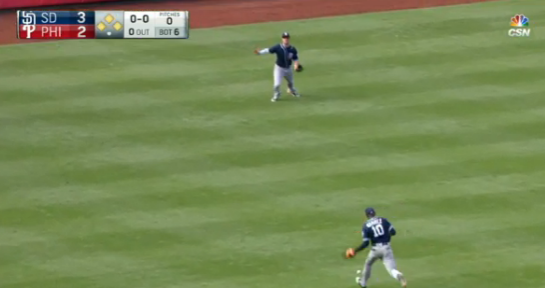I wanted to write about this sooner, but obviously, some things were more important. Yesterday, during the Phillies-Padres game, Darin Ruf hit a pop fly that landed in left field. It was actually nowhere close to the infield. So, of course, the umpire called an infield fly rule, which automatically calls the batter out. Odubel Herrera, who was running from second to third, was tagged out, and the result of the play was a double play.
Did this infield fly rule cost the Phillies the game yesterday? I don’t know. It’d be hard to tell, especially with hindsight being 20/20. And, there is that atrocious Phillies bullpen. So, to say the umpires caused the Phillies to lose is a bit of a stretch.
The purpose for the infield fly rule is for fielders to not be able to dupe the runners into easy outs. That certainly wasn’t the case yesterday, as the Padres shortstop, Alexei Ramirez, completely lost the fly ball.
Here’s the official rule on the infield fly from MLB:
An INFIELD FLY is a fair fly ball (not including a line drive nor an attempted bunt) which can be caught by an infielder with ordinary effort, when first and second, or first, second and third bases are occupied, before two are out. The pitcher, catcher and any outfielder who stations himself in the infield on the play shall be considered infielders for the purpose of this rule.
When it seems apparent that a batted ball will be an Infield Fly, the umpire shall immediately declare Infield Fly for the benefit of the runners. If the ball is near the baselines, the umpire shall declare Infield Fly, if Fair.
The ball is alive and runners may advance at the risk of the ball being caught, or retouch and advance after the ball is touched, the same as on any fly ball. If the hit becomes a foul ball, it is treated the same as any foul.
If a declared Infield Fly is allowed to fall untouched to the ground, and bounces foul before passing first or third base, it is a foul ball. If a declared Infield Fly falls untouched to the ground outside the baseline, and bounces fair before passing first or third base, it is an Infield Fly.
Rule 2.00 (Infield Fly) Comment: On the infield fly rule the umpire is to rule whether the ball could ordinarily have been handled by an infieldernot by some arbitrary limitation such as the grass, or the base lines. The umpire must rule also that a ball is an infield fly, even if handled by an outfielder, if, in the umpires judgment, the ball could have been as easily handled by an infielder. The infield fly is in no sense to be considered an appeal play. The umpires judgment must govern, and the decision should be made immediately.
When an infield fly rule is called, runners may advance at their own risk. If on an infield fly rule, the infielder intentionally drops a fair ball, the ball remains in play despite the provisions of Rule 6.05 (L). The infield fly rule takes precedence.
That certainly didn’t look like ordinary effort to me.
Let Larry Andersen take it away.
[soundcloud url=”https://api.soundcloud.com/tracks/258602800″ params=”color=ff5500&auto_play=false&hide_related=false&show_comments=true&show_user=true&show_reposts=false” width=”100%” height=”166″ iframe=”true” /]

